-- Washington State Birding --
March's Point Rd., Anacortes, was our most northerly birding area
This is our best photograph of a male Hooded Merganser.
They are not easy to get close to, we've discovered.
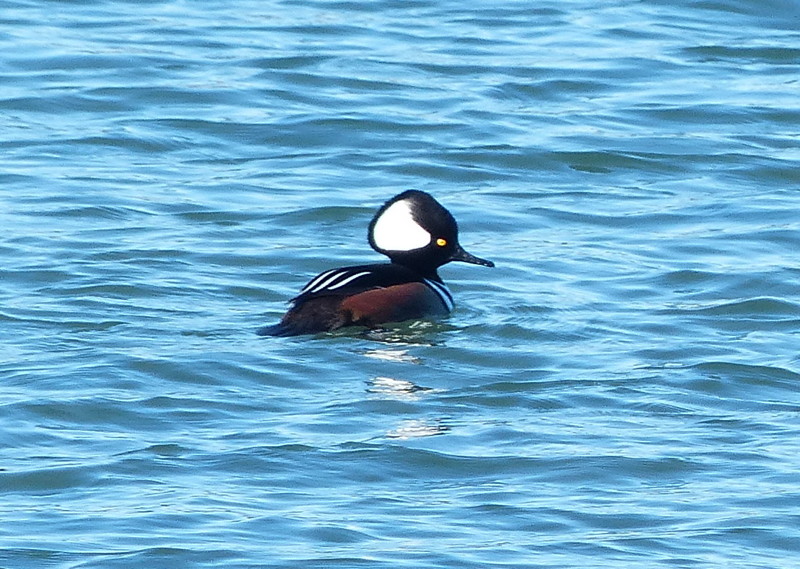
The female Hooded Merganser was feeding while the male seemed to be more concerned with me getting too close to him.

Several Northern Pintails were swimming about, apparently oblivious to us.


The female Hooded Merganser was feeding while the male seemed to be more concerned with me getting too close to him.

Several Northern Pintails were swimming about, apparently oblivious to us.

On Padilla Bay, we found hundreds more Northern Pintails.

Although the Pintails were the predominant species, there were some Wigeons, Mallards, and a few Green-winged Teals, another new species. In this photo, one of the female Green-winged Teals is visible near the center bottom with a male ahead of her about half way to the edge of the photo. They were all busy feeding and preening as the tide was coming in over the flats.


Although the Pintails were the predominant species, there were some Wigeons, Mallards, and a few Green-winged Teals, another new species. In this photo, one of the female Green-winged Teals is visible near the center bottom with a male ahead of her about half way to the edge of the photo. They were all busy feeding and preening as the tide was coming in over the flats.

Two male Green-winged Teals can be seen at the bottom of this photo.

Driving around the north end of March's Point, I spotted this loon. He was mostly underwater, so we had to be quick to catch this photo. I had originally identified this as a Pacific Loon, but I was later informed that it was a Common Loon "coming into breeding plumage." The more angular shape of the head and its prominent bill, are two identifying features.

Annamarie spotted another new species for the day, a Belted Kingfisher. We observed him diving from his perch to the water and back up again.


Driving around the north end of March's Point, I spotted this loon. He was mostly underwater, so we had to be quick to catch this photo. I had originally identified this as a Pacific Loon, but I was later informed that it was a Common Loon "coming into breeding plumage." The more angular shape of the head and its prominent bill, are two identifying features.

Annamarie spotted another new species for the day, a Belted Kingfisher. We observed him diving from his perch to the water and back up again.

On the west side of March's Point, Annamarie spotted this Kingfisher in a tree.

He has a different profile when facing into the wind.
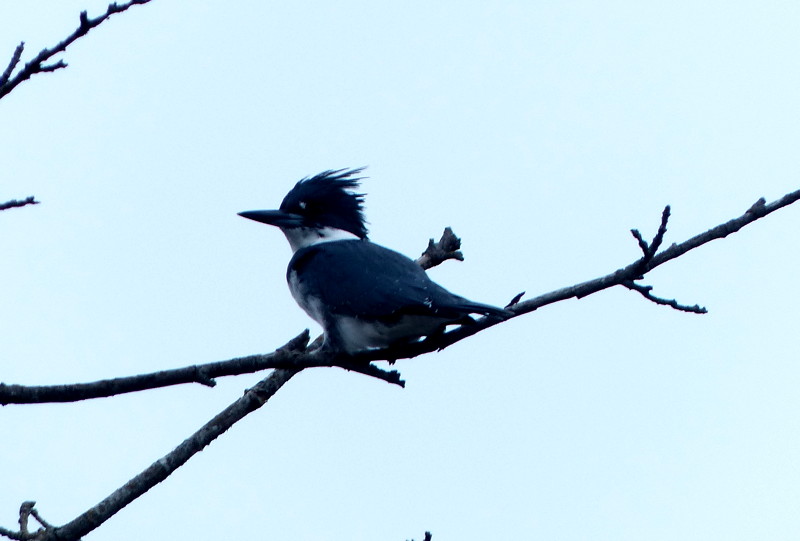
Red-shouldered Hawk - We were surprised to see this hawk so low and close to the road. He patiently waited while we backed the car up to park and took his photo.

It was quite unusual for us to see two hawks perched this close together.
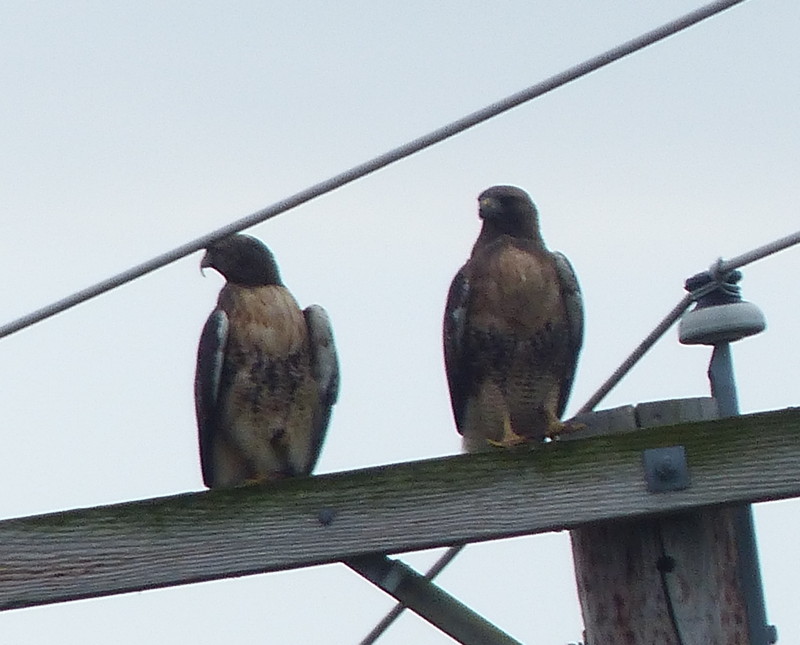
Great Blue Heron - She seemed interested in us as she approached from the other side of a drainage ditch. A second after I snapped this photo, she plunged her head into the water and came out with a nice plump looking fish. It was still wriggling as she swallowed it whole.

We had never seen a heron perch on a light before, but there were no trees near this spot.
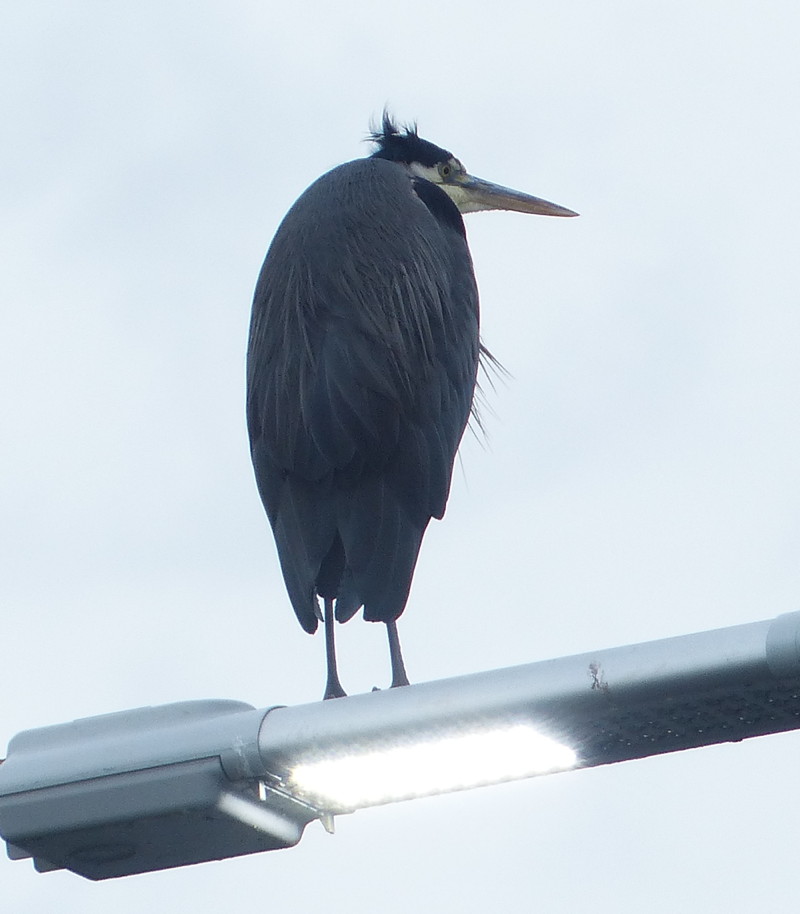

He has a different profile when facing into the wind.

Red-shouldered Hawk - We were surprised to see this hawk so low and close to the road. He patiently waited while we backed the car up to park and took his photo.

It was quite unusual for us to see two hawks perched this close together.

Great Blue Heron - She seemed interested in us as she approached from the other side of a drainage ditch. A second after I snapped this photo, she plunged her head into the water and came out with a nice plump looking fish. It was still wriggling as she swallowed it whole.

We had never seen a heron perch on a light before, but there were no trees near this spot.

Brewer's Blackbird
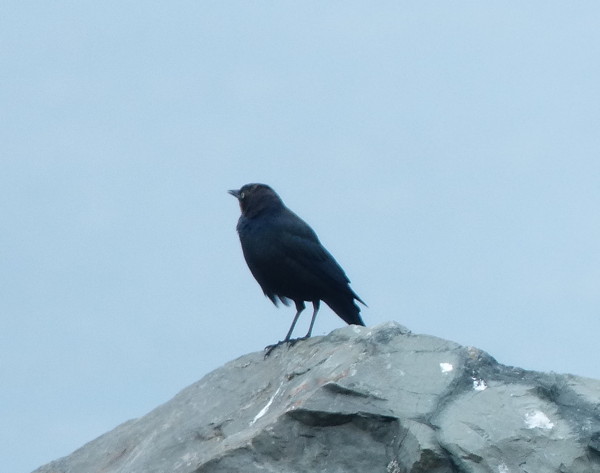
Fir Island, just west of Conway
This was our first day identifying six new species. At Fir Island, just west of Conway, WA,
we found hundreds of Snow Geese, a new species for us. There were probably 500 feeding in a field
quite close to the road, unafraid of our presence. In the same area we spotted over a thousand
Mallards and swans. We assumed these were Trumpeter Swans, but there might have been Tundra Swans in the mix.


These Surf Scoters were much closer to the ferry.

A Double-crested Cormorant, drying his wings.

Port Angeles, Sequim and Ediz Hook
This pair of Black Oystercatchers were a new species for us. We found them at John Wayne Marina in Sequim. Since they are selective in where they feed it isn't easy to photograph them. They feed on marine invertebrates, including oysters, snails and squid but no fish. When they are not wading in water, their bright pink legs are quite noticeable.
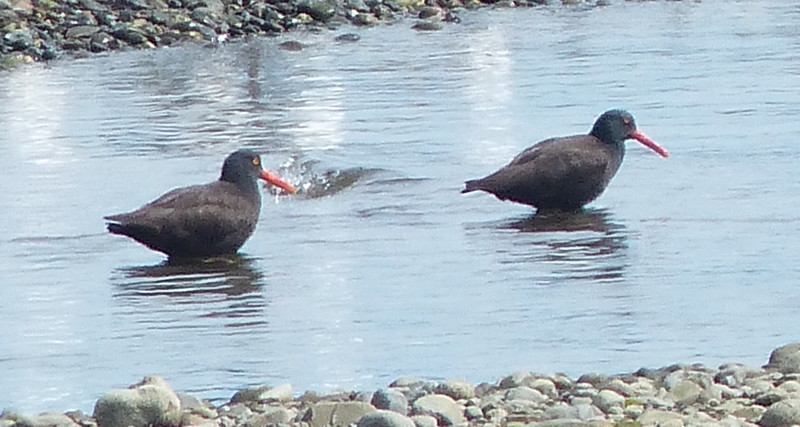

A single pair of Brant were enjoying the sun at Ediz Hook near Port Angeles. These are more often found in flocks.

These may be the first Western Grebes we'd ever seen from land. They feed in open water and we spotted these at Ediz Hook.
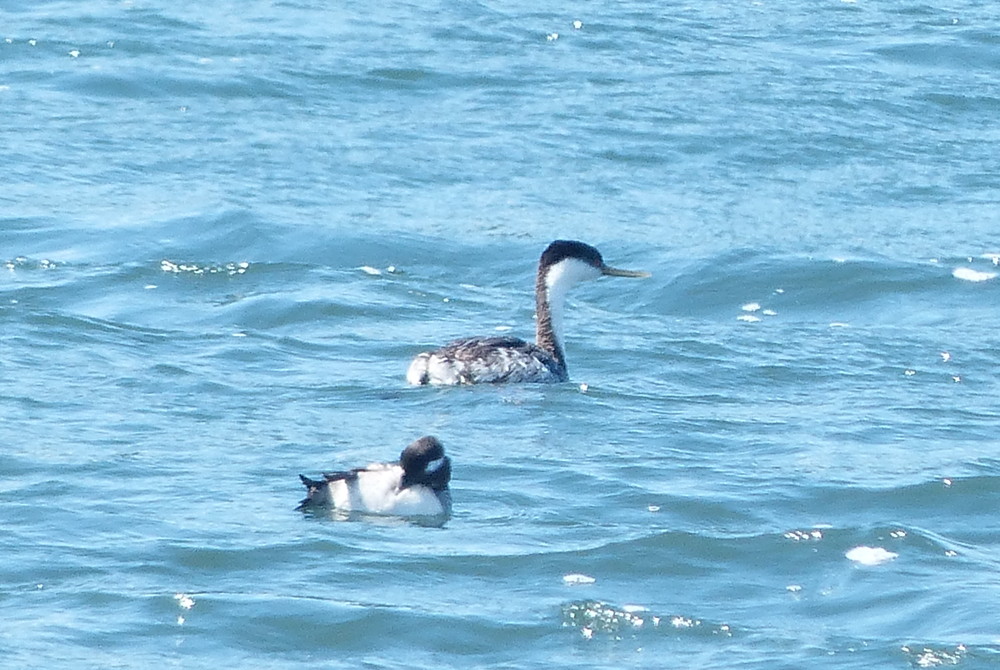

These may be the first Western Grebes we'd ever seen from land. They feed in open water and we spotted these at Ediz Hook.

Today we got our first eagle photos near Dungeness Spit in Sequim, WA. First we found a single Bald Eagle, high in the top of a fir tree.

Within sight of the first Bald Eagle we found these two perched on the top of another fir tree.

Over a mile from the first three, we found two more perched on top of a power pole. The one on the left is a juvenile so he doesn't have the white head, but is nearly full size.


Within sight of the first Bald Eagle we found these two perched on the top of another fir tree.

Over a mile from the first three, we found two more perched on top of a power pole. The one on the left is a juvenile so he doesn't have the white head, but is nearly full size.

Not far from the eagles, we found three Trumpeter Swans feeding in a recently cultivated field. Annamarie snapped this photo out of our car window.


At the site of the once famous Three Crabs Restaurant, south of Dungeness Spit we found this pair of Wigeons close to the shore.

At Sequim's John Wayne Marina we found a collection of Wigeon, Canada Goose, crows, and gulls. This gull caught our eye as being a different species than what we typically see, but afterfurther study we have concluded he might be a juvenile Glaucous-winged Gull, mostly because of his thick bill.


At Sequim's John Wayne Marina we found a collection of Wigeon, Canada Goose, crows, and gulls. This gull caught our eye as being a different species than what we typically see, but afterfurther study we have concluded he might be a juvenile Glaucous-winged Gull, mostly because of his thick bill.

Protection Island Spring Migration Cruise
Protection Island is at the south east corner of The Strait of Juan de Fuca. It's the only nesting spot in the North West US for numerous birds including Cormorants, Rhinoceros Auklets, Tufted Puffins, and many gulls.


The day we were there, thousands of Rhinoceros Auklets could be seen feeding from the east of the Island to Point Wilson. Roger Risley, our naturalist explained that this time of year twice a month in the moon cycles, the tides were strong enough to bring up enough food for small fish to support feeding the Auklets. On the other weeks they would fly daily to the Frasier River to feed which was longer but better feeding. This time of year was nesting time so they would feed all day then return to their nests on the Island to feed their chicks.


Pigeon Guillemonts were also present in large numbers.

I know, this photo is too grainy. The Surf Scoters wouldn't let us get close enough for a good photo and would take to the air.


I know, this photo is too grainy. The Surf Scoters wouldn't let us get close enough for a good photo and would take to the air.

Rounding the west end of the Island we saw large numbers of Harbor Seals and Elephant Seals. A large flock of Brant were on the spit. Roger said they would soon be gone on their migration.


Annual rainfall on the island is only 15 inches, insufficient to support a forest of trees. But sufficient water does supplement what rain does fall in the form of wet fog, coming from the north and west, so the trees on this side of the Island do survive and provide the homes for many Bald Eagles. This was as close to the island as boats are allowed to go. We were able to get close to the sand bar at the west end, however.


This is one of many Bald Eagles we saw from the boat. They feed on the thousands of chicks and smaller birds this time of year.


Small white specks can be seen on this south side of the island, near the top on the right side. Those are some of the thousands of nesting gulls.

Zooming the camera in on one of those areas, Glaucous-winged Gulls can be seen. They lay eggs on grass placed in small depressions in the soil. We had the chance to see an eagle fly over one of these areas, causing hundreds of screaming gulls to take to the air. Roger explained that the gulls had recently discovered that the eagles avoided being close to the two houses on the island so the gulls have been nesting more heavily there. He also mentioned that some of these gulls have crossbred with Western Gulls.


Zooming the camera in on one of those areas, Glaucous-winged Gulls can be seen. They lay eggs on grass placed in small depressions in the soil. We had the chance to see an eagle fly over one of these areas, causing hundreds of screaming gulls to take to the air. Roger explained that the gulls had recently discovered that the eagles avoided being close to the two houses on the island so the gulls have been nesting more heavily there. He also mentioned that some of these gulls have crossbred with Western Gulls.

We were early returning to Port Townsend so we were treated to a short tour of the sand bars between Marrowstone and Indian Islands. These Caspian Terns were a new species for this log. We also saw Oyster Catchers, but I was not quick enough to get a photo.


These Harlequin Ducks were a treat to see. I would probably have missed them but being on a boat with 24 experienced birders, there isn't much chance for a species to get missed.


Point-No-Point and Norwegian Point Park, Hansville
This was our first visit to this Park, which is less than a mile West of Point-No-Point.
Annamarie spotted three cormorants perched on pilings. One of them looked different and I could see the red on his face before we got out of the car. We thought for sure this was a Red-faced Cormorant. But after consulting the experts, it's been determined he was a Pelagic Cormorant with a generous amount of red in his face.
Red-faced Cormorants also have blue in their bill but this cormorant didn't.


A short distance down the beach a flock of Brants landed and seemed to be feeding on grass at the water line.


Two pairs of Mallards landed in the water behind the light house at Point-No-Point.


This Northern Flicker landed high in a fir tree above our house.

The spots on his front body and the shape of his bill indicate a Northern Flicker. This one was at Point-No-Point, two miles north of the above Flicker. While I was adjusting the backlight on the camera, he flew away and I missed seeing him fly.


The spots on his front body and the shape of his bill indicate a Northern Flicker. This one was at Point-No-Point, two miles north of the above Flicker. While I was adjusting the backlight on the camera, he flew away and I missed seeing him fly.

A pair of Mallards.

Red-necked Grebe

Mew Gull

Golden-crown Sparrow

Song Sparrow

Great Blue Heron

American Wigeons


Hooded Merganser

Pied-billed Grebe

Barrow's Goldeneye

Buffleheads


Red-necked Grebe

Mew Gull

Golden-crown Sparrow

Song Sparrow

Great Blue Heron

American Wigeons


Hooded Merganser

Pied-billed Grebe

Barrow's Goldeneye

Buffleheads

A young Eagle

Near Kingston
Bald Eagle This eagle had just finished his breakfast on a low limb on our neighbor's tree. We had never had one land this low down and so close to our house.

Northern Flicker On the cedar tree just off our deck.
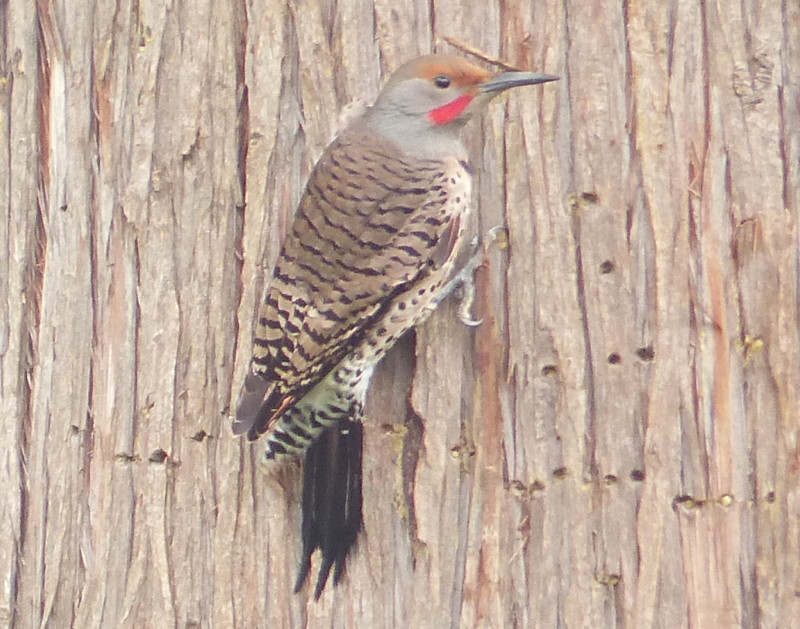

Northern Flicker On the cedar tree just off our deck.

Spotted Towhee

Flocks of Steller's Jays came through our yard quite often but never stayed long. This one landed in our neighbor's fir tree.

Male Rufous Hummingbirds have been difficult to photograph for me somehow. The migration must be slowing down as this one wasn't being challenged by other males, which is usually the case. They are so busy with that, it's hard to know how they have any time to eat.

Northern Flicker


Male Rufous Hummingbirds have been difficult to photograph for me somehow. The migration must be slowing down as this one wasn't being challenged by other males, which is usually the case. They are so busy with that, it's hard to know how they have any time to eat.

Northern Flicker

Pileated Woodpeckers came through our property quite often in June. They landed near the bottom of a tree, hopped around a little, then hopped their way upward. This one decided to chip some bark off a large fir tree. We often heard them in the woods both calling and hammering as only they can do. Just after I got this shot, he demonstrated how he could hang on with his right foot while scratching his head with the other foot.


A Red-breasted Sapsucker showed up high on a large fir tree next to our deck.

American Crow

Anna's Hummingbird

We saw this Bald Eagle land on the top of a fir tree on our bank overlooking Puget Sound. Several eagles had been riding the rising air currents along the bluff most of the day.
It's not often one lands in this tree but we had a good view of him. He appeared to be the same one I photographed three weeks ago, (see below) still in molt but he was looking much better now.

A Bald Eagle landed on a limb in our neighbor's tree. He was in a molting period, which is why he looks messy. Young eagles apparently molt five times before they reach adult plumage, which takes about five years. The adults molt after the breeding season, and their wing feathers molt at a separate time than the rest of their feathers.


A Bald Eagle landed on a limb in our neighbor's tree. He was in a molting period, which is why he looks messy. Young eagles apparently molt five times before they reach adult plumage, which takes about five years. The adults molt after the breeding season, and their wing feathers molt at a separate time than the rest of their feathers.

Bald Eagles were quite common in our neighborhood.

Song Sparrow The outline of Mount Baker can be seen faintly behind him.

Port of Kingston
Pied-billed Grebe
Surf Scoter - We saw a dozen or more of these at the Kingston ferry dock.
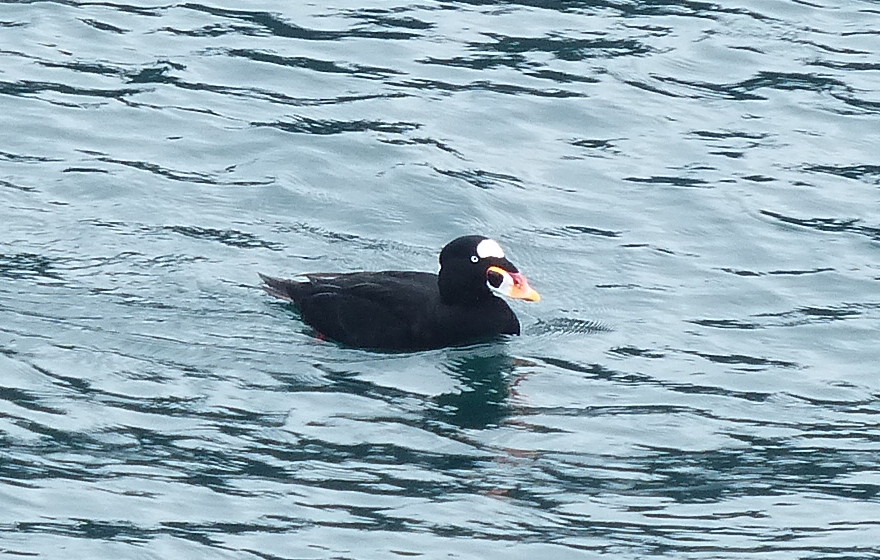

Arriving in Edmonds by ferry, we saw another flock of Surf Scoters, reminding us of the ones we had seen leaving Kingston. In this photo he has his neck extended with the white patch behind his head slightly visible.

Seen from another angle the white patch is more distinct.
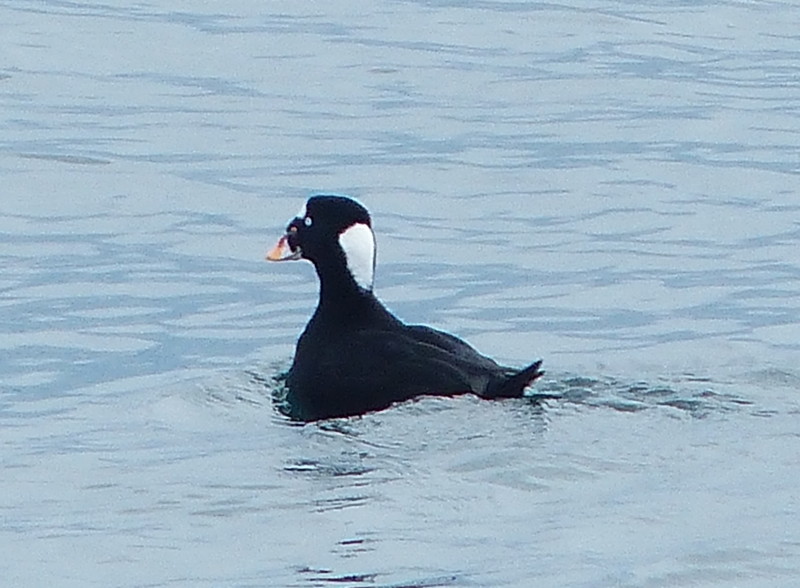
Pigeon Guillemont 
Seen from another angle the white patch is more distinct.


Arness Park - Kingston, WA
In this photo of a flock of Wigeons, a rarely seen by us Green-winged Teal appears in the lower right corner.
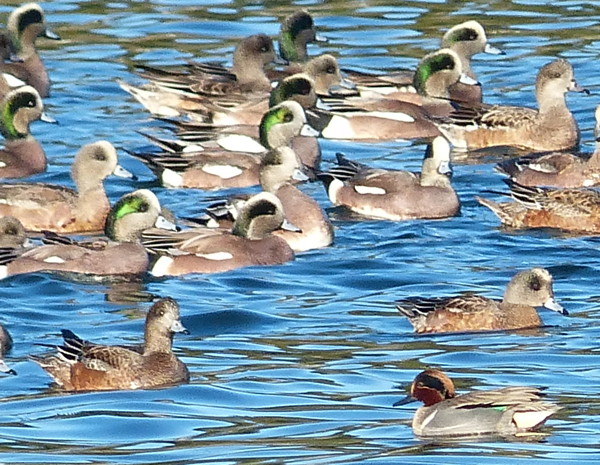

Red-breasted Mergansers were fishing further away along the shore.
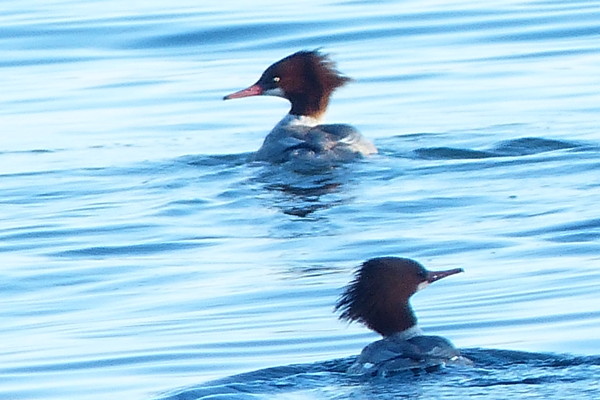
Great Blue Heron at low tide.

Three Barrow's Goldeneyes in the bay. The plumage on the male is not yet to breeding stage. I had to wait several minutes for him to take a break from preening himself before I could get a good photo.


Bufflehead

Bufflehead (female)

Horned Grebe


Bufflehead

A pair of Barrow's Goldeneye

This Greater Yellowlegs was a pleasant surprise for us, having seen our first of these only two days before.

This Great Blue Heron was across the road from the park in a lagoon. He was one of three in this area.

Dunlin
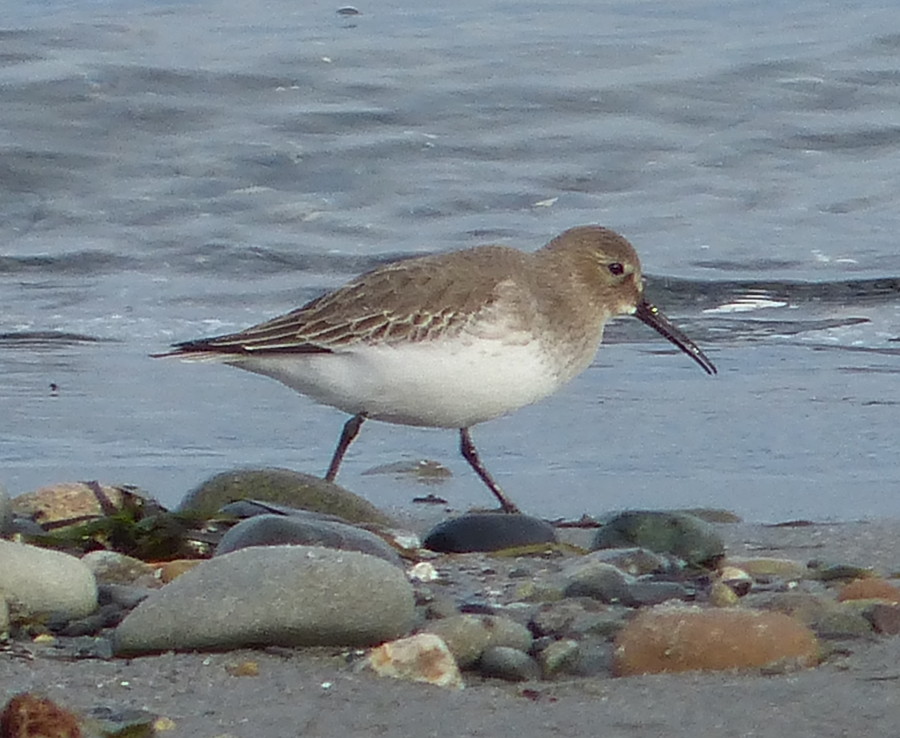
Sanderling (Note the shorter bill)
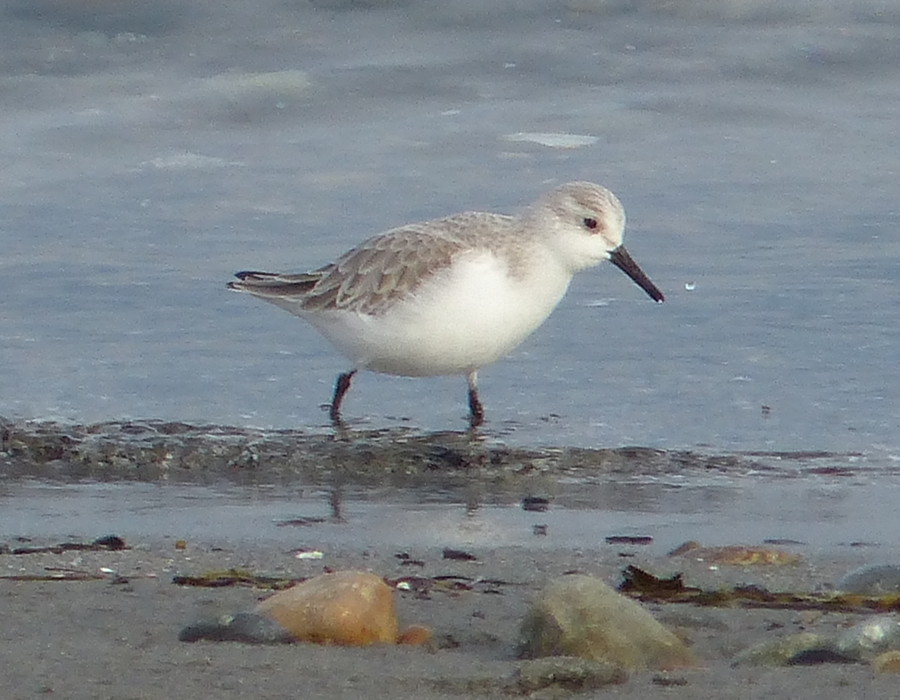
Fort Ward Park, Bainbridge Island
American Wigeon males

American Wigeon females

Glaucous-winged Gull (yawning)

Red-breasted Merganser
 <
<Barrow's Goldeneye drying his wings

Barrow's Goldeneye with his mate following

Double-crested cormorants, adults and juveniles
 >
>This photo shows two Pelagic Cormorants with a Double-creasted on the upper left.

Our new DCM FZ200 camera quite easily captured this Pelagic Cormorant in flight.

Surf Scoter

Bainbridge Island Circumnavigation
(The vessel was Admiral Pete, an 80 foot powered catamaran.)
Common Goldeneye, getting airborne in Eagle Harbor.
Red-necked Grebe

Barrow's Goldeneyes, near an old ferry boat in the DOT maintenance yard.

Pigeon Guillemont

Double Crested Cormorant - Leaving Eagle Harbor, heading south.

Three Brandt's Cormorants above with a Pelagic Cormorant below.

Western Grebes

Surfbirds - At Blakely Rocks off SE corner of Restoration Point.

Surfbirds and Black Turnstone

Black Scoter - Progressing up Rich Passage

White-winged Scoter

Harlequin Duck

Pair of Harlequin Ducks

Someone spotted this Common Raven flying overhead which George
identified, noting that the tail is different from the one on a crow.


Rhinoceros Auklet

Brandt's, Pelagic, and Double-crested Cormorants.

Common Murre

Bald Eagle

Belted Kingfisher

Long-tailed Duck

Long-tailed Ducks, flying.

Peregrine Falcon under the Agate Passage Bridge.

Brants in flight.

Three Surf Scoters at Fort Ward Park on an earier date.

Oyster Plant Park Pier, Poulsbo
Horned Grebe at Poulsbo's Oyster Plant Park.
female Barrow's Goldeneye

Horned Grebes

Bufflehead male

Bufflehead female

White-winged Scoter - male

White-winged Scoter female

Glaucous-winged Gull (juvenile)
 >
Glaucous-winged Gull (adult)
>
Glaucous-winged Gull (adult)
This Common Goldeneye was interested in what he was finding near the pier so we got a very close look at him.

These two Surf Scoters were further away and the first we had ever identified.

A Red-breasted Merganser

Purple Martin. This was a male, perched near a gourd style nesting box.

This was a female, leaving the box.

Seabeck Pier
Hooded Merganser
These Grebes were feeding near the Seabeck Dock, which was under renovation so we could not walk out on it.


On the beach near the pier we found this pair of American Wigeons.

Greater Yellowlegs

A small group of European Starlings were searching the tidal rocks near the dock.

Pigeon Guillemots as seen from the dock.
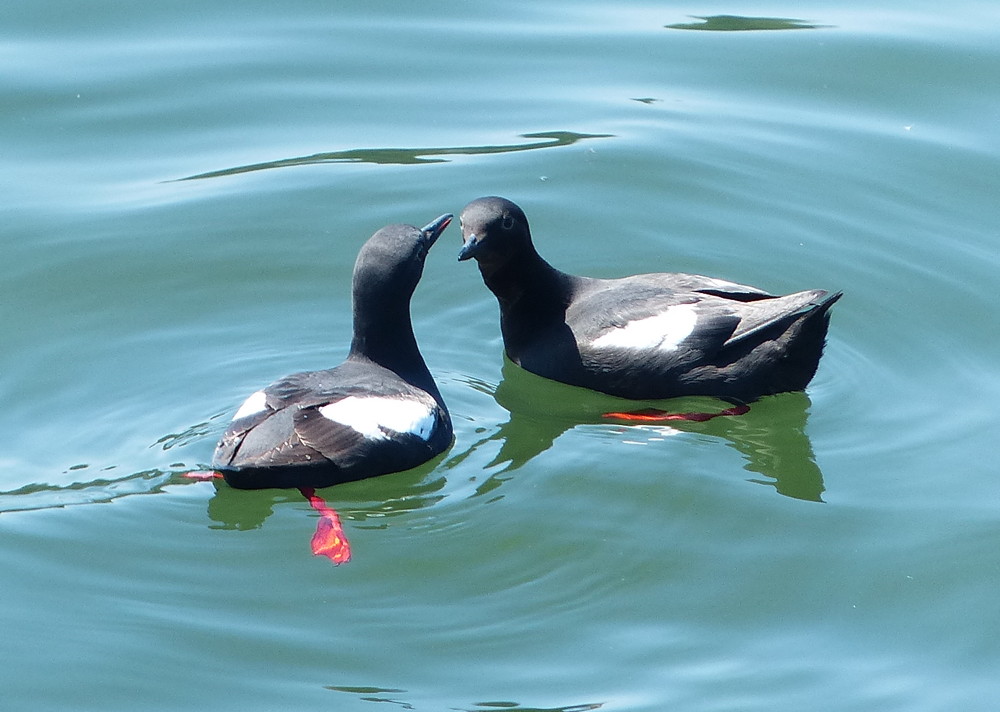
Nisqually National Wildlife Refuge
This was our first visit to this Refuge. The winter birds are still in numbers and we discovered some birds that don't normally show up until later in the spring.
The Northern Shoveler was a new species. These birds were so busy feeding that their heads were under water most of the time. I finally set the camera on burst mode for one drake and was able to pick out this single photo with his head up.


Tree Swallows were earlier this year, probably because of a mild winter.



We thought this was a Sparrow, but learned that although the markings are similar, the sharply pointed bill and other color and markings determine that it's a female Red-winged Blackbird.


American Coot are usually seen in a group, but this one was all by himself. They are listed as an abundant winter resident here.


This was the third Greater Yellowlegs we had seen in the past month, all in different locations.


Green-winged Teal feeding in the shallow tideland water.

Al spotted this Mew Gull flying and he landed within a good photo distance from the boardwalk we were on. The black on his outer wings when flying, make him an easy identification.


A 2nd winter Glaucous-winged Gull wasn't an easy identification for us. The color of the bill and plume seem to fit.


It's easy to get close to the Mallards here. This drake must see a lot of people on the dike bordering his feeding grounds.


Female Mallard showing off her pretty blue wing plumage as she flies.

American Wigeons are plentiful around here this time of year, but we don't usually get to see them up as close as this.

We saw numerous Great Blue Herons on the walk, but these two seemed more colorful than most.

It is unusual to get this close to an American Robin.


We saw numerous Great Blue Herons on the walk, but these two seemed more colorful than most.

It is unusual to get this close to an American Robin.

This was the only Bald Eagle we saw today. He landed in a tree across the road from the refuge and
doesn't seem nearly as large when perched in this huge fir tree.


Back to Birding Areas Next to South Carolina and Georgia Birds